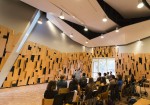People grabbing a snack in the Music Café while visiting the newly constructed Evelyn and Mo Ostin Music Center can hear snippets of music from the students practicing in the ensemble rehearsal space next door.
The two-building facility includes a one-story modern recording studio and a three-story building that houses offices, classrooms, a rehearsal studio, a cafe and social spaces.
While construction for the center was completed last quarter, only the Music Café and ensemble room are open for student access. For now, the mixing rooms and the studio are closed until the music department finishes installing recording equipment, said Loren Nerell, a recording technician at the UCLA Herb Alpert School of Music and the Department of Ethnomusicology.
Music producer and UCLA alumnus Mo Ostin partially funded the two-building project with a $10 million grant. The Associated Students UCLA Board of Directors provided the rest of the funding for the $300,000 project and approved the construction in January 2012.
“I haven’t had a chance to perform there yet, but it’s gorgeous and a great venue for my future, hopefully,” said Andrea Yu, a fourth-year music performance student who has been playing the cello for 16 years. “The acoustics are great.”
The new center also includes four mixing rooms and one modern recording studio. Each room’s walls are lined with wooden panels architecturally designed to keep sound waves from flatly bouncing off the walls. The panels help create a more evenly distributed and pure sound.
The mixing rooms are each isolated in the basement and stand on floating floors that help absorb the vibrations from the music sounds that are created within.
Three of the mixing rooms are identical and will be equipped with an 80-note keyboard, speakers and a flat screen TV. The last mixing room was specially constructed for cinematic film music production, Nerell said.
The computer room is currently open for classes on how to use audio software such as Logic Pro, with which students can create music of any genre from classical to hip-hop and electronic dance music. Each 21.5-inch iMac desktop is attached to a keyboard and a pair of headphones, and students can be seen dancing in their seats while enjoying their work.
The large recording studio features two small sound-isolating rooms – one for vocals and another for instruments – a control room and a large recording room.
Joseph Johnson, a fifth-year Korean studies student and senior supervisor at the Music Café, said the coffeehouse has had heavy traffic since it opened last quarter.
“When musicians take rehearsal breaks, (they) don’t have to run across the street or go all the way down to Kerckhoff to grab a snack,” Yu said.
While walking by the building, students can see musicians rehearsing through the geometric glass windows along the corners of the ensemble and studio rooms.
Eric Mendoza, a second-year physics student, said he regularly reads and studies during breaks in between classes under the exterior steel-framed screen walls and canopies that control natural light.
Nerell said he thinks of the new cafe as a way to better keep in touch with his colleagues and students.
Before the Music Café opened, Nerell said that music students and faculty members he knows had to rely on a “coffee hour” in the office to meet and socialize.
Nerell added that the addition has opened up new spaces for professors who previously did not have offices.
UCLA hopes to complete the final details of the center by the end of this quarter, Nerell said.
